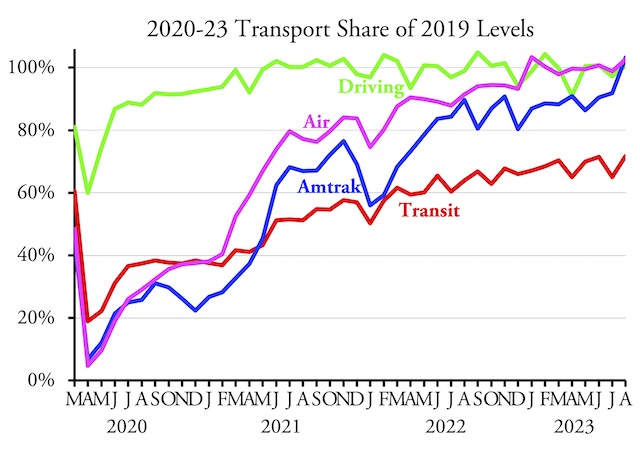Highways, airlines, and Amtrak all carried more travel in August 2023 than the same month before the pandemic, according to data recently released by the Department of Transportation. Urban transit, however, is languishing at less than 72 percent, and it would be even lower except that August had one more business day in 2023 than in 2019. Agencies such as the Regional Cleveland Transit Authority and San Jose’s Valley Metro that were behind on their data reporting have caught up, so can’t be used as an excuse for the industry’s overall poor performance.
Highway vehicle miles and transit ridership data were released yesterday. Amtrak issued its monthly performance report, including passenger-miles earlier in the week. Airline data are based on Transportation Security Administration counts, which are updated daily. Air passenger-miles are reported by the Bureau of Transportation Statistics but they are further behind, having issued data only up through June.
Most downtowns are still doing poorly. Downtown Washington, for example, is seeing record vacancy rates as more companies announce that they aren’t renewing leases almost weekly. Since around 45 percent of transit commuters in major metropolitan areas worked in central-city downtowns before the pandemic, the movement of these jobs to other parts of urban areas that aren’t well served by transit has struck a permanent blow to transit ridership. Of course, I’ve argued that this is the fault of transit agencies that have been so heavily subsidized that they haven’t felt the need to provide good service to non-downtown commuters.
Transit agencies such as San Francisco BART that were heavily dependent on fares to fund their operations are now seeking voter approval for tax increases so they can keep operating relatively empty trains and buses. A recent survey found that voter support for Bay Area transit is declining. Though supporters still number more than 50 percent, measures on the ballot next fall will require 55 percent approval. BART and other agencies will no doubt use some of their increasingly scarce funds to lobby educate the public about the supposed benefits of subsidies to their operations.
Both urban and rural Highways saw more travel in August than in 2019. Urban roads carried 0.4 percent more vehicle-miles of travel while rural roads 1.0 percent more for a nationwide average of 0.7 percent more. The biggest increases were in Arizona, where driving was 43 percent greater than in 2019; Alaska (19%), Idaho (12%), Maine (11%), New Jersey (7%), and Arkansas (7%).
August Amtrak passenger-miles and air travel were both about 3 percent more than in 2019. Of course, domestic airliners carry more than 100 times as many passenger-miles as Amtrak, and when international air passenger-miles that start or end in the U.S. are added, the total is more than 200 times Amtrak.
As usual, I’ve posted an enhanced spreadsheet with detailed transit ridership data. The raw data are in cells A1 through JJ2267; annual totals are in columns JK through KF; columns KG through KI compare August 2023 with August 2019 and August 2022 as well as 2023 to date compared with the same months in 2019; mode totals are in rows 2270 through 2291; transit agency totals are in rows 2300 through 3299; and urban area totals are in rows 3301 through 3791. These enhancements can be found on both the ridership (“UPT” for unlinked passenger trips) and service (“VRM” for vehicle-revenue-miles) worksheets.









completely off this topic, but there was a study on induced demand from a guy who used to run the la highway system that essentially said “duh, of course you expand the freeways, it takes load off smaller arterials”.
i think i first encountered it here, but i can no longer find it. here, or brookings, where it no longer exists.
can you or anyone point me in a direction if you have it?
If not this one, then use the search bar above right:
https://ti.org/antiplanner/?p=19869
Passenger air moves more people because train infrastructure is lacking. There is a very good video on why this is by alan fisher titled “How America’s Largest Railroads are Ruining our Supply Chains.” In short though, PSR is causing traffic issues because freight companies refuse to double rail cause of the taxes and its probably going to stay that way as long as the railroad itself is privately owned.